
This article was originally published May 31, 2016. In honor of the 50th anniversary of the 1968 Marathon de la Route today, we are re-publishing this story.
The Mazda Cosmo Sport. This space age sports car from the spunky little company in Hiroshima is now a bona fide blue chip classic, a poster child of vintage Nihon sought after by collectors and auction addicts. It is an exquisite car. Its design was delightfully out of this world, as was its revolutionary engine. It even has racing pedigree: a short but important stint at Marathon de la Route. This race is often mentioned in the same breath as the Cosmo’s history, one of the most epic rallies in motorsport history. It’s a mad mad mad mad race.
The History
 Marathon de la Route is now often recognized as 84 Hours of Nürburgring, though it was also once famously known as the Liège-Rome-Liège Rally. The origin of this race lies with the Royal Motor Union of Liège, Belgium. The rally came about in 1931 because RMU’s previous rallies to and back from Biarritz, France (approximately 1400 miles) and Madrid, Spain (approximately 2000 miles) were deemed not tough enough. So to raise the stakes even higher, the destination was moved further to Italy, hence the word “Marathon” in its name.
Marathon de la Route is now often recognized as 84 Hours of Nürburgring, though it was also once famously known as the Liège-Rome-Liège Rally. The origin of this race lies with the Royal Motor Union of Liège, Belgium. The rally came about in 1931 because RMU’s previous rallies to and back from Biarritz, France (approximately 1400 miles) and Madrid, Spain (approximately 2000 miles) were deemed not tough enough. So to raise the stakes even higher, the destination was moved further to Italy, hence the word “Marathon” in its name.
Ironically, Rome actually wasn’t touched in Liège-Rome-Liège. The iconic city merely signified inclusion of the epic Italian Alpine mountain passes of Stelvio, Gavia, and Vivione. Keeping to the inconsistent naming, the rally didn’t really begin in Liège, either. Contestants would start from the city of Liège in convoys to Spa-Francorchamps 20 miles away and exit the circuit at the Stavelot Hairpin, where the rally officially began at 11 pm Wednesday night.
From Spa, it was a journey of 3000-plus miles through Belgium, Germany, Austria, Italy, Yugoslavia, and back. Sure, that’s some distance, but what’s the big deal? But consider this: the first time Pat Moss (sister of Stirling Moss and a successful rally driver in her own right) raced in the Marathon, her inquiry of the locations of night stops was met with laughter. The rally demanded driving 4-day-4-night nonstop, with breaks for the driver and car totaling a whopping one full hour. Hallucination among drivers was a marquee feature of the event!

Now, the Stelvio Pass has 75 hairpins, and Liège-Rome-Liège included three such passes. On top of that, the allotted times between rally check points led to fairly high speeds. Grueling, mad, sadistic? Why was this event so? Well, turns out that RMU’s rally master and General Commissioner — one Maurice Garot — believed that the best rally should only have one finisher: the winner. This was his way of achieving that. It should be noted that Garot was not just any nutso yahoo; but a nutso yahoo revered in international rally circles.
Over time, people became less and less comfortable with the speed of the rally on public roads. Accidents at Le Mans and Mille Miglia eventually led many countries, including Italy, to withdraw participation from the Marathon. This caused a route change in 1956 to Liège to Zagreb, Croatia and back, though it was still called Liège-Rome-Liège. From 1961, it was extended to Sofia, Bulgaria and renamed Liège-Sofia-Liège. By the mid-1960s, the Marathon was completely moved to the Nürburgring.
Enter the JNCs
This is when things got more interesting for JNCs. 1965 was the first running of the Marathon de la Route at the Nürburgring. Dubbed the 82 Hours of Nürburgring, it was now in a more controlled environment. However, Garot’s spirit of intensity (or is it insanity?) remained; extensive timing and penalty schemes still kept the cars and drivers running non-stop. In other words, the hallucinations kept coming.
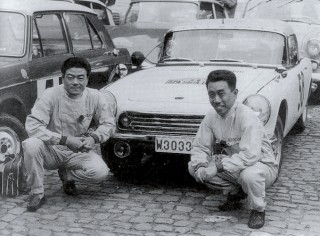
Of the 35 cars on the starting grid in 1965, only 24 finished. Among the smorgasbord of European cars and Mustangs was a Honda S600 co-driven by Nobuo Koga (right) of Japan. It finished 18th overall. This was not Koga’s first time at the Marathon, however; he also co-drove an S600 in 1963 with Giichi Suzuki (left). Sadly, that outing led to an accident which claimed Suzuki’s life.
Koga returned in 1967 in a Mazda 1000 (aka Familia Coupé) but unfortunately crashed out of the race. There was also a Honda S800 in the race that year, piloted by two Belgians, that didn’t finish due to engine problems. By now, the Marathon was one of the few races that incorporated the full Nordschleife and Südschleife, with two more hours slapped on to make it the 84 hours of Nürburgring. That may be a lot of hours, but it was still 12 hours shy of the 4-day-4-night ordeal of the original event. That year saw only 13 of the 43 starters crossing the finish line, and even the course vehicle crashed! The Marathon remained as notorious as ever, though Garot might say that’s still 12 cars too many to cross the finish line.
A (Green) Hell of a Proving Ground
Even when it was called the Liège, Marathon de la Route’s notoriety earned the respect of rally enthusiasts. It was regarded by many as the greatest rally of all, and rally legend Erik Carlsson called it his favorite. It demanded unfathomable stamina and concentration from the drivers, not to mention bravery and gall. The runnings at the Nürburgring were also where many “ringmeisters” such as Jacky Ickx and Vic Elford cut their teeth. As for the machine, it certainly was one of the ultimate all-encompassing trials of a car. Perhaps nothing else in the world provided a better, and more rigorous, testbed. For this reason, Mazda chose the Marathon in 1968 as the venue to showcase its newfangled rotary engine.
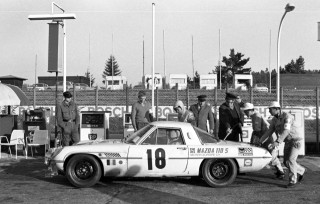
At the time, Mazda was still relatively new to racing. But it was determined to win. At home in Japan, its R360 Coupé and Carol were being raced, while the Familia saw victories in Singapore and Macau by 1966, at the hands of none other than Yoshimi Katayama. With rotary engine development coming to fruition, it was only natural to test and prove the technology through the crucible of racing. At the encouragement of Kenichi Yamamoto, chief engineer of the rotary, preparation to conquer the Marathon began.
On the powertrain side, Kunio Matsuura and a young Takaharu “Koby” Kobayakawa developed a racing version of the 10A engine with aluminum housing and modified intake. The end result was an output of 130 horsepower at 7000rpm — a 20-hp bump from stock. At the same time, Hiroshi Yamamoto obtained parameters of the Nürburgring and studied the circuit through simulations in Mazda’s computers in one of the earliest such applications in the industry. Testing was carried out at Mazda’s Miyoshi Proving Ground as well as Suzuka. These were the first instances in history when the sound of an unmuffled racing rotary graced the world. It was so loud that nearby farmers complained that their cows had stopped producing milk!



The Race
Two racing-developed Cosmos were fielded for the 1968 Marathon de la Route, along with support crew and a huge stock of parts from Japan. Loaded onto a Japan Air Lines DC-8, this marked the very beginning of Mazda’s legacy — arguably dynasty — at international endurance racing. Imagine the courage, determination, excitement, and pride as the Mazda team took their singular sports car and powerplant to the most grueling race at the most infernal circuit in the world.
The Marathon’s reputation meant that many works entries were driven by top notch drivers. Mazda thus recruited Marathon veteran Nobuo Koga along with Yoshimi Katayama (signing autographs and sitting facing right in photos below) and Masami Katakura to drive the #18 Cosmo. The #19 car was piloted by an all-Belgian team experienced with the race: Jean-Pierre Ackermans, Yves Deprez, and Leon Last.

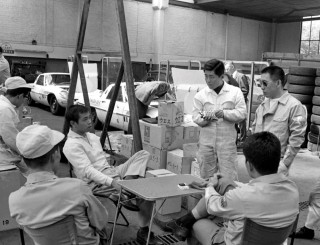
The two cars were identical save for the red stripe on #18 and yellow stripe on #19. Besides the modified engine, racing developments beyond the Series 1 Cosmo Sport included an extended wheel base that enhanced stability, power brakes, and a larger grille opening. Cosmetically, the cars were de-bumpered, dressed in rather modest liveries, and wore two pairs of Marchal driving lights.
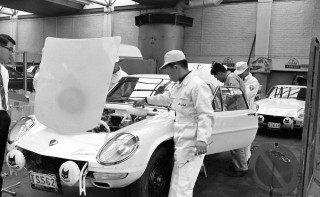
On Wednesday, August 20th, all the Marathon entrants gathered at the traditional starting point: the courtyard of Palais des Princes-Evêques de Liège, the Prince-Bishop’s palace. 44 cars were on the manifest that year, including many 911s, various BMWs, two Mini Cooper S, three Lancia Fulvias, an NSU TT, and a Saab Sonett. Amongst these, the Cosmo Sport appeared positively exotic. Other JNCs at the race consisted of two Datsun 1600 Bluebirds and a Honda S800.

At the palace courtyard, Mazda mechanics and engineers made their final inspection and adjustments before the race stewards scrutineered the cars. The race car convoy then took off toward the Nürburgring for the race proper, the beginning of which suffered inclement weather. By Friday morning, the top place was being battled for by Porsche and MG. By the 80th hour, both Cosmo Sports were still running strong, occupying 4th and 5th places behind two 911s and a Fulvia. Then, the #18 car, piloted by Katayama at the time, veered off the course into the Eifel forest.



What happened was that the rear axle was weakened by a hole drilled in order to mount an instrument. After most of the race, the axle finally succumbed to the stress on the ‘Ring, and a wheel came off. This was a major accident, but fortunately Katayama emerged unhurt. #18 was out, but #19 maintained its position for the rest of the race and finished 4th.
The Legacy
With both cars running so well for most of the race and an almost-podium finish, the Cosmo Sport clinched a remarkable result at the 1968 Marathon de la Route. This is especially true given that it was the first endurance race outing for Mazda, the Cosmo Sport, and the rotary engine. In addition, the race officials also awarded Mazda a safety prize for Katayama walking away from #18’s accident unhurt.

Mazda’s excellent showing at the Marathon sowed the seed of its penchant for endurance racing in the future. It would return to the Marathon the following year with a triplet of R100/Familia Rotary Coupés. It would also take on 24 Hours of Spa with those cars, with Le Mans not long after, then Daytona, and all the way to the 787B’s victory in 1991. These are stories for another time, but they all began with the Cosmo Sport at the epic Marathon de la Route.

If racing improves the breed, then Mazda wasted no time putting those words to action. The development for the Marathon directly led to improvements in the Series 2 L10B Cosmo Sport, which appears largely identical to the Marathon racers. The upgrades were implemented in production one month before the Marathon in 1968.
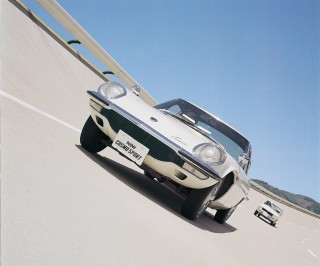
As for Marathon de la Route, it finally returned to its glorious former duration in 1971, becoming the 96 Hours of Nürburgring. This was also its final running. Mazda had moved on to other events by this time, although a hakosuka Skyline (dubbed “Datsun 2000”) did participate that year and finished in 8th place. Despite its utterly epic scope and nature, the history of Marathon de la Route is a bit esoteric these days, especially compared to the likes of 24 Hours of Le Mans. Nevertheless, there is a revival race that began in 2015.
For JNCers, this once “greatest of the world” race will likely forever be associated with Mazda and the Cosmo Sport. If the Cosmo is the “Spirit of Mazda” then the challenge Mazda mounted to conquer Marathon de la Route represents its valor and determination. Next time you read about the Marathon in an auction ad for a Cosmo, hopefully you’ll truly recognize it as a hard-earned badge of honor.
Images courtesy of Mazda, Wikimedia Commons.


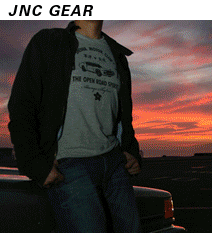
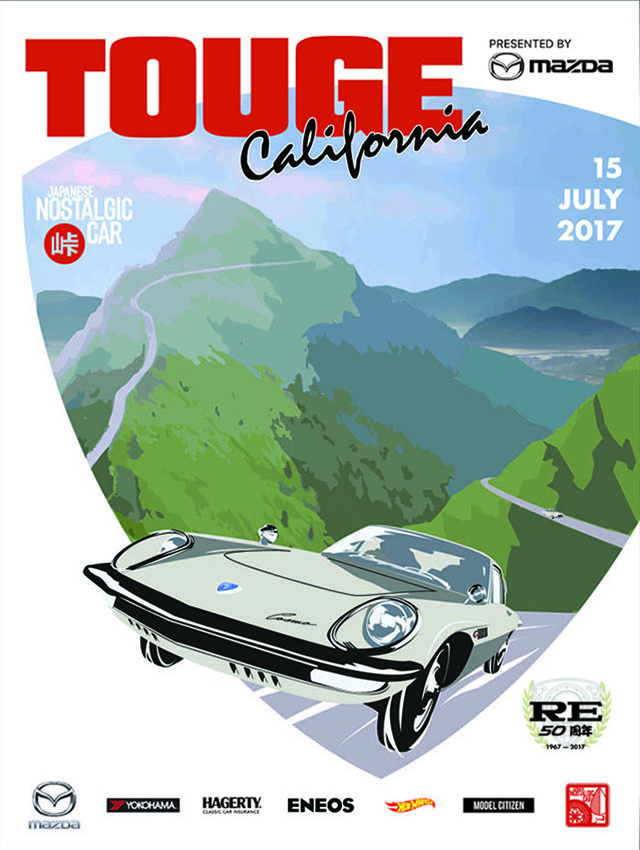
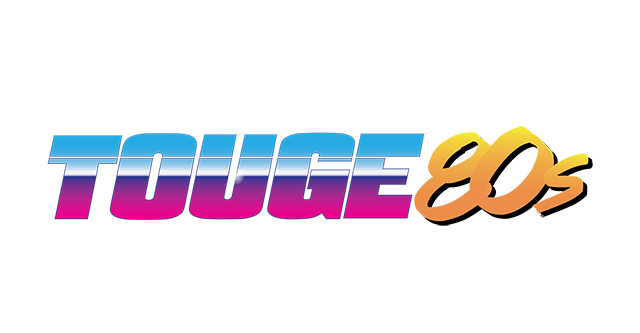

Fantastic article!
Makes me want to finish school even earlier, to put me one step closer to buying FC RX-7!
buy it! you just cant not to love it!
In Argentina for us in 1969 was an important year involved a team led by Juan Manuel Fangio with cars made – torino 380w – in the country and prepared by Oreste Berta .
for reference was the debut in an international race of a car produced entirely in Argentina.
http://www.f1-web.com.ar/84Nurburgring4.htm
1st place lancia
2 bmw
3 Standard – Triumph
4th torino
5th mazda
and only as a reference bonus this year 1969 I also ran a certain Luca di Montezemolo (yes, the same who imagine ) with a co-pilot called Cristiano Ratazzi , for many years president of Fiat Auto Argentina.
as a reference oreste berta is a great coach, Horacio Pagani (yes, the same who imagine) has him as a leader and friend. imagine the level of this man that one of his projects was to manufacture and compete in sport prototype against porsche and other monsters of the time.
Unfortunately the lack of financial support truncate the continuity of their projects but it was very important for the development and evolution in other categories .
http://www.porsche917.com.ar/bertalr/berta_01_hist01.htm
And is just a small part of their history. Enjoy!!!
Awesome read! Thank you so much for posting!
An interesting bit of trivia: the L10B Cosmo brakes are actually larger than the L10A brakes. The rotors themselves are bigger in diameter and the calipers are a little beefier. This necessitated the need for 15 inch wheels as opposed to the 14 inchers on the L10A.
Also, apparently, the L10A cars with the slotted grille were notorious for overheating, so many owners changed the nose out for the L10B piece. Which is probably why the race cars have the massive opening in the front.
Cheers,
David
Here,they were talking about famous rotary and japanese engines,drivers and mazda cars pedigree,not about any argentina car history.
So,next time, check the correct address to GEOWOLD OR NATGEO,YOU,STUPID,DOWNSOUTH UNDER ,WITH EUROPEAN ITALIAN COMPLEX…?
Hi Nel.
I’m sorry you feel uncomfortable the historical reference trying to provide for a time when factories considered such events as the ultimate test of their products. I trying also provide reference characters competing and became important in the automotive industry. not only the participation of Mazda was important and recognized but also understand brands and factories against competition began. if a team led by Fangio and Oreste Berta , a reference to one of the most advanced car manufacturers in the world Horacio Pagani , perhaps greatest achievement makes Mazda . not only your victories make you who you faced big but against you . That is the merit of Mazda . so I thought the reference was valid.
Considers that such oreste berta was able to design, develop and manufacture a few years later a sport prototype and compete against porsche 917 and 908, alfa romeo, matra 650, lola t70 of the moment and beat them. and everything from a small factory in the middle of nowhere ( his workshop is known as La Fortaleza not without reason ) and all with less than 30 years old.
Hey, chill. Watch your language, okay? No need to get all political over an innocent comment. His comment wasn’t a spam or discriminatory (unlike yours).
Btw I thought all car guys are supposed to have mutual respect, at least on this board, no?
Epic story and race! Tremendous research effort, Dave!
I can hope for a documentary about the cars ,driver and the race.
This is awesome, I have a 1/24th model of this car with this race livery. I have often wondered the historical significance of it. Now I need to build it for sure!
Great Article! We have one of these photos in our showroom… excellent!